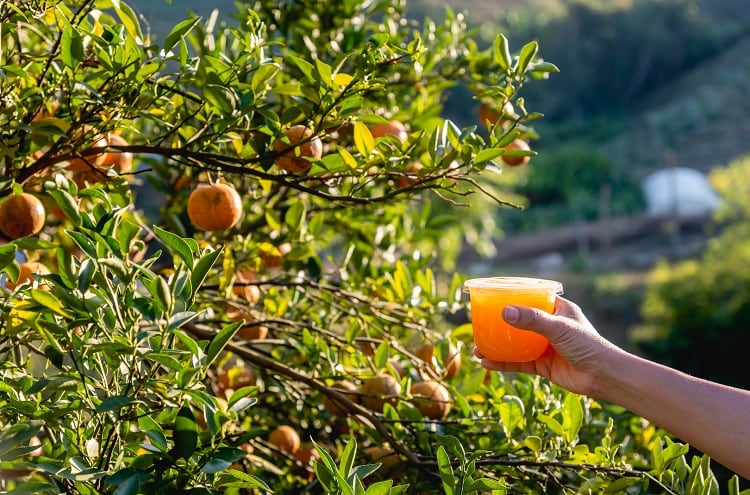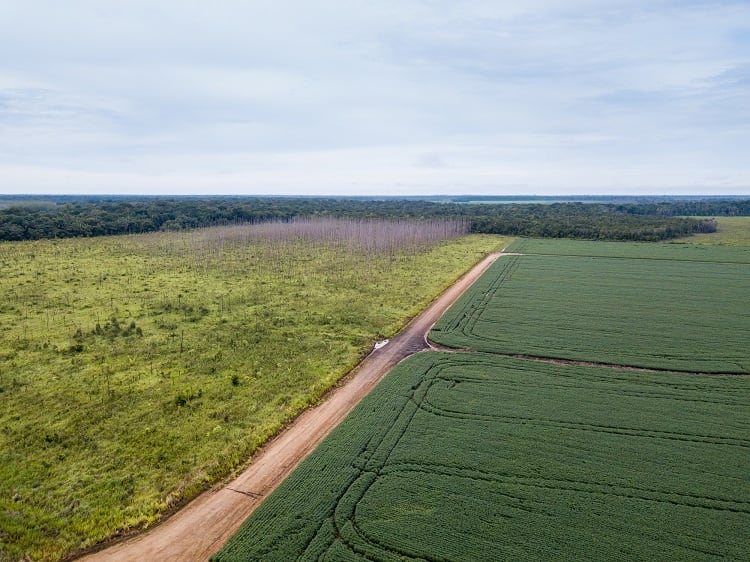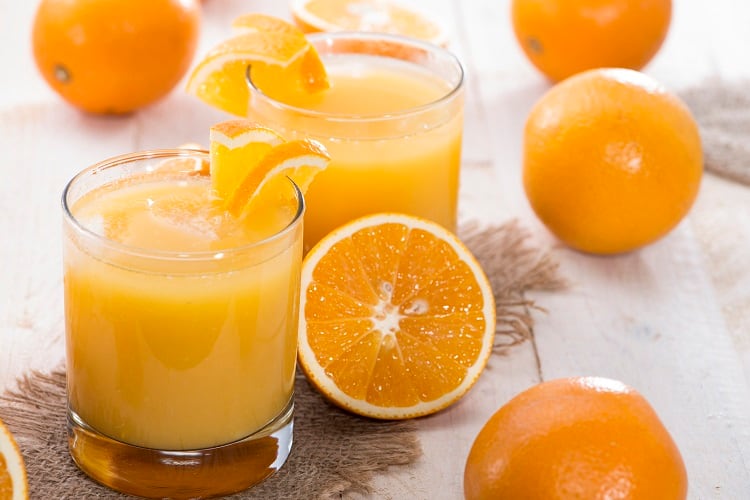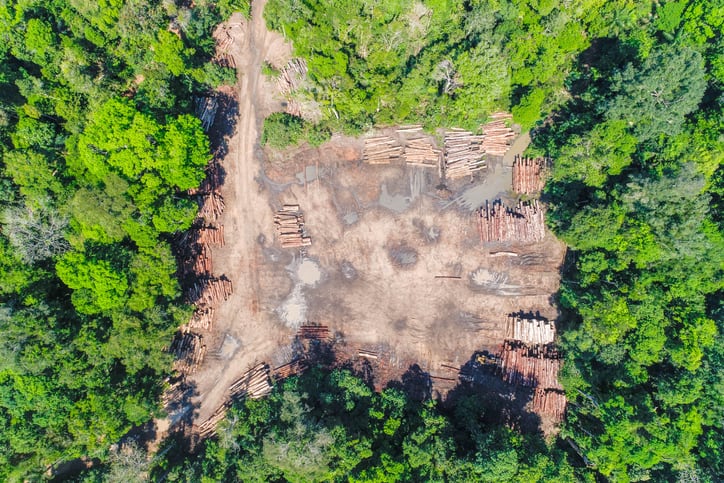Brazil is the global leader in orange juice production. The country’s most recent season saw an estimated 1.157m tonnes of orange juice – in frozen concentrate and not-from-concentrate juice formats – produced.
Most of the juice comes from oranges grown along the citrus belt in São Paulo State and the western portion of Minas Gerais State. But in these regions, land is ‘very expensive’, explained Tatiana Campos, institutional relations director at the Brazilian Association of Citrus Exporters (CitrusBR), which represent orange juice majors Citrosuco, Cutrale, and Louis Dreyfus Company (LDC).
This makes it challenging for farmers to purchase more land for increased production. “To maintain competitive, they cannot simply acquire more and more land,” said Campos
To address this challenge, the sector has been investigating a technique known as densification, whereby more citrus trees are planted in the same area to increase yield. The process has taken ‘a lot of years’, but results to date are proving positive. “Productivity has increased by 210%,” the institutional relations director told FoodNavigator.
Densification: increasing yield on less land
In fact, the sector has achieved a 210% increase in productivity on 45% less land. Aside from the citrus belt being located on high-end real estate, land size has reduced because the citrus sector is competing with other crops in this region.
São Paulo State is also known for sugar cane, meat, and coffee production, amongst other known commodities. One of key reasons area dedicated to citrus cultivation has reduced in recent years is because some farmers are prioritising other crops, such as sugar cane, explained Campos.
Three companies dominate the orange juice sector in Brazil: Citrosuco, Cutrale, and Louis Dreyfus Company (LDC). And these three companies are represented by the Brazilian Association of Citrus Exporters (CitrusBR).
Citrosuco, Cutrale, and LDC are responsible for 37% of global orange production, around 65% of global orange juice production, and 75% of all juice traded worldwide. “Out of 10 glasses of orange juice consumed in the world, seven were produced by our members,” said Tatiana Campos, Institutional Relations Director at CitrusBR.
In addition, a proportion of land is dedicated to industry. “The State of São Paulo is one of the most industrialised states in Brazil, we have companies like Unilever, Embraer, Bayer… all of these global companies are producing in the State of São Paulo,” Campos explained.
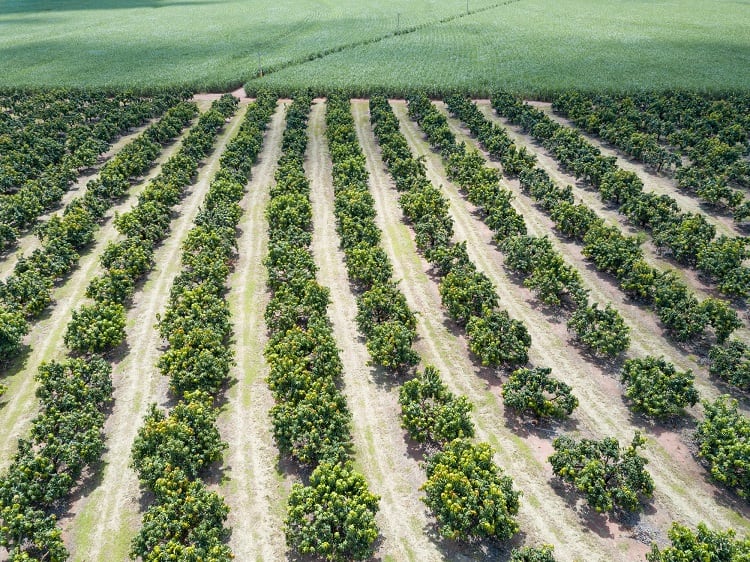
The sector has, ‘for years’, been studying densification in order to boost yield in the face of limited agricultural expansion. Densification is an ‘intensifying technique’, said Campos, which centres around planting more tress in the same area. “It seems simple, but it’s very complex because you have to take it step-by-step.”
It’s all about finding the optimal number of trees that can be grown in a certain area. “There is a ceiling,” explained Campos, insinuating that it’s not a question of planting as many trees as possible.
The results speak for themselves. In 2018, each hectare averaged 374 trees or less, whereas this year, each hectare is averaging up to 506 trees per hectare. At the same time, productivity has increased from 21 tonnes per hectare to an average of 38 tonnes of oranges per hectare – representing an increase of 81%.
Challenges and biodiversity wins
The advantages associated with densification in Brazil’s citrus sector appear to outweigh the advantages.
One challenge Campos cited, for example, lies in logistics. With less room between trees in the orchard, some machinery is too big to ‘circulate’, she explained. In these instances, smaller machinery is required.
However, there are major wins to be had, including financial. Looking at inputs vs outputs, densification requires less fertiliser per tree, for example. By increasing production, economy of scale also plays a role in reducing input costs.
There is also a biodiversity win, we were told. When native vegetation is planted near the citrus trees, while implementing densification, farmers have observed an uptick in productivity. This can be put down to increased pollinator numbers, Campos suggested.
Recent research commissioned by CitrusBR found that 80% of all honey produced in the State of São Paulo comes from the citrus belt. Production over the last 16 years has increased by 136%. “This showed us that it is possible to have co-existence – between oranges, orange juice, and bees.”
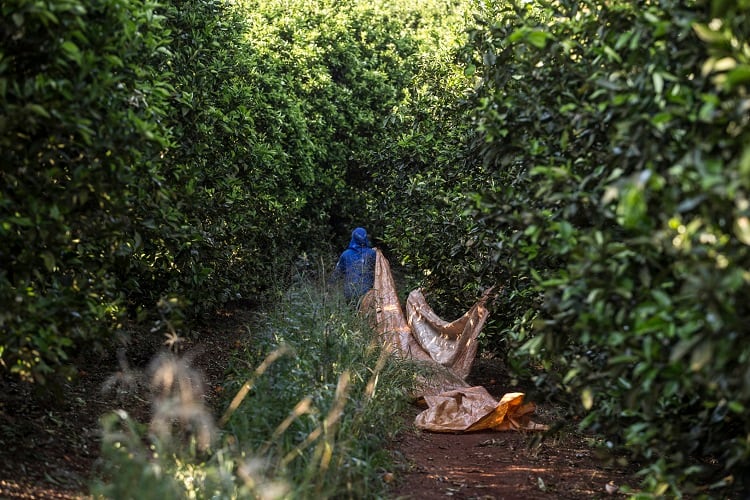
The technique has proved so successful that CitrusBR expects it could also benefit other geographies facing similar challenges. In the UK, for example, agricultural land is limited and yet the country has high population numbers, suggesting that increased productivity would be welcomed.
Reputation: How is Brazil’s citrus sector perceived abroad?
In Europe, the perception of Brazilian agriculture is not always rosy. According to Global Forest Watch, from 2000 to 2020, Brazil experienced a net chance of -28.1Mha (-5.9%) in tree cover. During this period, around 70% of tree cover loss occurred in areas where the dominant drivers of loss resulted in deforestation.
However, Brazil’s citriculture industry is completely unrelated to the Amazon rainforest. The citrus belt is 2,400 miles away from the Amazon, which Campos likened to the distance between Berlin and Cairo.
The citrus sector is working to preserve biodiversity across the citrus belt, and thanks to the Brazilian Forest Code, a significant amount of land has successfully been preserved. According to Brazilian law, farmers are required to leave 20% of the area in a property, or 80% in the Amazon, to forest or its native vegetation. “Today, we have managed to preserve an area that totals more than 150,000 hectares, which is the same area as the city of London,” said Campos.
While all this is happening within Brazil, we wanted to know whether the sustainability message is getting out to customers and consumers abroad, or whether Brazil’s citriculture sector is tarred with the same brush as some of Brazil’s livestock and soy farmers implicated in deforestation and forest degradation.
Recent research commissioned by CitrusBR, and conducted by a European consulting company, surveyed bottlers and retailers in Europe. The results were ‘very good’, said Campos. “All of them recognise our companies as top quality. We export 60-70% to Europe and have done so for a long period now.
“We have a good reputation because our clients have been demanding for a long time and we work closely with them. Our members receive visits from either due diligence bodies, certification bodies, or clients every week.”
The next step is to ensure that positive perception is passed onto the consumer. “We believe it is important to communicate to other retailers and consumers, because the image of our country in the last few years has not been so great, especially regarding deforestation. Sometimes we feel…that people associate deforestation with our sector.”
Campos continued: “We have a good reputation with people who know us. That’s our [goal], to have more people know us and to have our [sustainability] data.”
What does the future hold?
Brazilian citriculture has been exporting since the 1960s, which is at least a decade or two earlier than other agricultural sectors within the country. Citriculture has, and will continue to be, important for the country, explained Campos.
It employs a significant number of people, to begin with. “Citriculture is very labour-intensive because the oranges are picked by hand. Our sector alone generates around 200,000 jobs directly and indirectly in Brazil.” This is particularly relevant in Brazil, she explained, which has a ‘very high’ unemployment period of around 12-13%, depending on the period.
Citriculture is also important for Brazil’s local economies. The citrus belt encompasses 330 municipalities around the states of São Paulo and Minas Gerais, a good number of which are not located in more rural areas. “It generates a local economy because there are farms, the processing companies, logistics terminals…it’s a very complex economy and it helps a lot of people to live and produce there, while generating revenue for these cities.”
Another financial win lies in the overall revenue the sector brings to the states. “The sector generates almost $200,000 per year in taxes. It has GDP of $6.5bn and exports $2bn.”
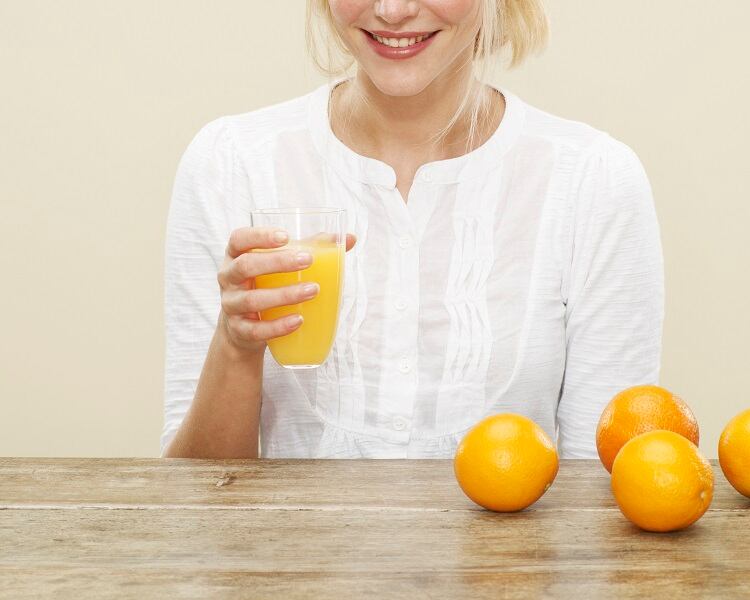
What does the future hold for Brazil’s citrus sector? CitrusBR wants to focus on communicate these advantages to the wider world, all the while ‘maintaining relevant’ to consumers.
“The main challenge for us, on behalf of the fruit juice sector, is to keep our product relevant for end consumers. Today, there are lots of [beverage] options: flavoured waters, sodas, and so on. We have to constantly remind consumers that orange juice is a good choice for health,” explained Campos. “Orange juice contains vitamin C, folate, potassium…it’s a food actually, rather than a soda.”
And in terms of sustainability messaging, the trade association hopes that consumers perceive Brazilian-sourced orange juice as a ‘good choice for sustainability’. “Every time you drink an orange juice from Brazil, you are helping to preserve an area larger than the city of London.
“It’s also a good choice when you think about non so developed countries, like Brazil. You are generating jobs there, providing revenue for people who don’t necessarily live in big cities. Today, that’s the challenge: to communicate.
“We know that consumers know almost nothing about Brazil, and we have to show them that they can continue consuming our products and that they are sustainably made.”


